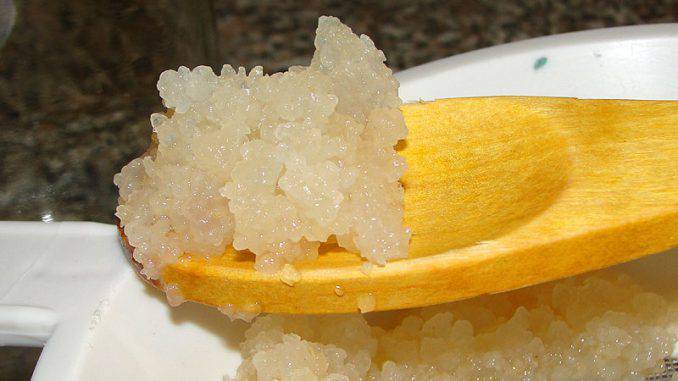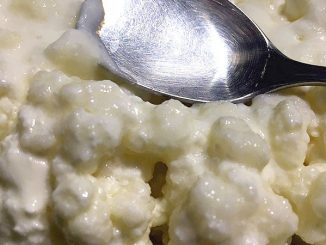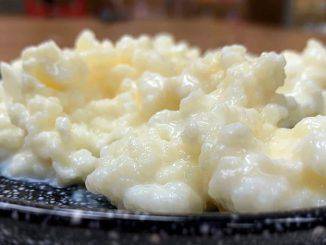
The water kefir grains are also known as Tibicos, Tibi, Sugar kefir, Japanese water crystals, or even Japanese algae (although kefir has nothing to do with algae).
According to some sources, water kefir grains are also thought to originate from Mexico, where they supposedly thrived in the sugary water of the Opuntia (prickly pear) cactus.
These grains are almost transparent, brittle, and look like crystals. They are a dairy-free and vegan-friendly alternative to milk kefir, offering similar beneficial bacteria and yeast.
Water Kefir is a water-based, lactose-free fermented drink rich in beneficial probiotic bacteria. It is pleasant to the taste, and because of its light sweetness, fresh aroma, and low carbonation, it can be a probiotic-rich and cheaper homemade replacement for a soda drink. Water Kefir is an excellent source of beneficial probiotic bacteria, and it also contains valuable digestive enzymes, organic acids, and a large set of B vitamins.
The water kefir drink is made with grains (small, translucent, gelatinous structures composed of bacteria and yeast), water, and sugar.
Just like milk kefir and kombucha, the water kefir grains are a SCOBY, or in other words, a “Symbiotic Culture Of Bacteria and Yeast“. However, water kefir’s SCOBY bacterial and yeast composition is different from milk kefir and kombucha.
Although water kefir contains fewer bacteria and yeasts than milk kefir, water kefir still has far more beneficial bacteria than other probiotic products, like yogurt or buttermilk.
Sucrose (or plain white sugar) consists of glucose and fructose. The bacteria and yeast in water kefir convert glucose into glucuronic acid, and fructose is converted mainly into acetic acid. That is why, although it is prepared with sugar, the fully fermented water kefir is almost sugar-free. Therefore, water kefir is also suitable for people with diabetes, but in small quantities and provided that they monitor their blood sugar levels.
Often water kefir is put in a group with Kombucha as a variant of a vegan probiotic. However, water kefir and kombucha are very different. Kefir produces an entirely different set of bacteria and yeasts compared to kombucha, which is more healthy.
Like most fermented beverages, water kefir contains small amounts of alcohol – usually from 0.5% to 2.0%, depending on the fermentation stage.
Benefits of water kefir
Water Kefir helps to achieve optimal health, strengthens the immune system, and prevents various diseases. Most importantly, it restores good digestion, which is the key to health and longevity.
When the body is unbalanced, pathogenic bacteria and yeast can outgrow the beneficial ones. So the symptoms of indigestion, various food allergies, headaches, frequent colds, skin rashes, and other more severe disorders appear.
A teacup of the drink before each meal balances the bacterial environment in the digestive tract, providing organic acids, enzymes, and necessary vitamins to improve digestion and absorption of food.
Consumption of water kefir stops the growth of harmful bacteria and yeast and promotes the growth of colonies of beneficial probiotic microorganisms in the digestive tract.
It helps to balance the immune system and reduces inflammatory processes in the body. As a result, symptoms of Irritable Bowel Syndrome (IBS), including bloating, indigestion, diarrhea, constipation, nausea, fatigue, muscle aches, can be significantly relieved.
Kefir drink is known to harmonize the endocrine system and balance the hormonal synthesis, which has a beneficial effect on the whole body. Pigment spots can fade, as can many skin problems such as eczema, acne, and even psoriasis.
Regular consumption of water kefir is also known for its cleansing effect on the liver.
Due to its beneficial effect on hormonal balance and the synthesis of cortisol, regular consumption of water kefir is known to prevent the unwanted symptoms of PMS and menopause.
There are many cases in which the regular use of water kefir has also helped people with insomnia, depression, and even autism.
Water kefir is also the best (and probably the only) option of having a non-dairy and fully vegan probiotic.
Consumption of water kefir reduces the unhealthy craving for sweets and processed foods, often caused by the overgrowth of candida or other harmful microorganisms in the body.
How to make water kefir?
The water kefir grains (also called Kefir Crystals or Tibicos) ferment and quickly multiply when mixed with water and sugar.
For about 3 tablespoons of kefir grains you need about a liter of water and 3 tablespoons of sugar. A few raisins or other dried fruits should also be added, as they provide additional yeast and nutrients needed by the bacteria.

Tap water or well water work generally best. Hard water works better than soft water here! If your tap water is too soft, you could even add a pinch of baking soda to make it less acidic.
Water should be by all means non-chlorinated. Chlorine is strongly antibacterial and could seriously interfere with the fermentation process and even damage your kefir grains.
Organic unrefined cane sugar or brown sugar is generally best, but regular white sugar will also do the job fine.
Do not be tempted to use honey instead of sugar! Honey is a very beneficial product for your health, but it has antibacterial properties that adversely affect all fermentation processes.
Noncaloric sweeteners like stevia and xylitol are also not recommended. They to dot provide the water kefir grains with the nutrients they need.
Stir well the sugar into the water with a wooden spoon until fully dissolved.
Also, note that, like milk kefir, water kefir grains should not enter in contact with metal as this may interfere with their probiotic properties. It is best to use glassware and plastic or wooden tools.
Primary fermentation
During this initial or primary fermentation stage, do not put the lid on, but cover the jar with a thin kitchen towel or cheesecloth. Do not close the jar tight because, at this stage, kefir needs to breathe.

It takes approximately 24 hours for the initial (primary) fermentation to happen. So, after 24 hours, your kefir drink should have fermented.
You can check this by tasting the liquid. If the taste is still too sweet, then not all the sugar has metabolized, and you can let it ferment longer – up to 48 hours. The longer this initial fermentation lasts, the tangier and the less sweet your drink will get.
How long this initial fermentation will take also depends on the ambient temperature. In the winter months, the initial fermentation is usually finished after 24 to 48 hours. In the hot summer months, however, your water kefir may be ready after only 12 hours.
Secondary fermentation
Strain out the kefir grains from the fermented drink. The grains you just strained out can be stored in a smaller jar in the fridge in sugar water for the next batch.
The drink obtained from the initial water kefir fermentation should then be transferred to tightly sealed (flip-top) bottles for the secondary fermentation, a part of which is usually carried out in a fridge. The secondary fermentation may last from 24 to 48 hours, depending on the individual taste.
For secondary fermentation, you may add different fruits to obtain some extra taste and aroma. These could be fresh berries, peaches, apricots, bananas, pineapple, plums, concord grapes, apples, or pears. Sweeter fruits like peaches, apricots, bananas, or pineapples give additional nutrients to the fermenting kefir and boost secondary fermentation.
Alternatively, at this stage, it is also a good idea to add up to 20% of fresh fruit juice or even natural fruit syrup. That will supply the kefir bacteria with extra sugars that will feed them and boost the fermentation process.
During the secondary fermentation, the water kefir creates gases that build pressure in the bottles, exactly as expected – this makes the drink nice and fizzy.
But be careful! The pressure inside the tightly closed bottles can increase too much, and they may even explode! So, let out some of the pressure by “burping it” every 6-12 hours or so.
Following the secondary fermentation, the kefir drink loses much of its sweetness, despite the otherwise large amount of sugar you added. The resulting healthy liquid can be lightly carbonated.
After about 24 to 48 hours of secondary fermentation at room temperature, the tightly sealed bottles may be placed in the fridge. In this way, the drink gets nicely chilled, and the fermentation processes are slowed down to avoid excessive carbonation.
Note, however, that even though the low temperatures in the fridge may slow down the fermentation processes, they will not stop them. If you let your water kefir bottles for too long, the building pressure of fermenting kefir could make them explode even in the fridge. So, make sure you “blurp” your bottles at least every couple of days.



